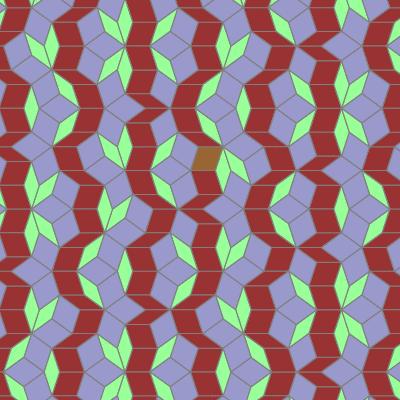Background
The Penrose tiling P2 is aperiodic and consists of two quadrilateral shapes: kites and darts. It is depicted in the image below, with kites in blue and darts in red:
On pp. 563–564 of the book Tilings and Patterns by B. Grünbaum and G. C. Shephard, some properties of this tiling are discussed. It is mentioned that, if one considers any increasing sequence of convex regions $R$ of the plane, the ratio $\rho(R)$ of kites to darts tends to the golden ratio $\varphi := \frac{1+\sqrt{5}}{2}$.
Grünbaum and Shephard proceed by writing:
Penrose pointed out that the irrationality of $\varphi$, and therefore of the limit of $\rho(R)$ as $R$ grows larger, provides an alternative proof that all tilings by kites and darts are non-periodic. This follows from the observation that in any periodic tiling (which is, of course, necessarily metrically prototile balanced) the ratio of the frequencies of the copies of the prototiles is necessarily rational.
When a given set of tiles only allows for nonperiodic tilings, the set of tiles is aperiodic. Hence the fact that $\rho(R)$ tends to $\varphi$ as $A(R) \to \infty$ implies the aperiodicity of P2. (Here, $A(R)$ denotes the size of the region $R$.)
Something similar occurs in the recently discovered aperiodic tiling with the hat polykite. If one considers the ratio of the amount of unreflected to reflected hats in an increasingly large convex region of the tiling, it will tend towards $\varphi^{4}$. As this number is irrational, this again provides a proof of the aperiodicity of the tiling.
Motivation
Suppose that in a tiling $X$, we have $\rho(R) \to \alpha$ as $A(R) \to \infty$. Here, $\rho(R)$ is calculated by considering the ratio of the frequency of two different types of tiles (these can be different orientations as well). Then the above two examples are instances of statements of the following form:
$$ X \text{ is aperiodic} \impliedby \alpha \text{ is irrational} . \tag{1}$$
What I wonder, is whether the one can also prove assertions with the implication in the opposite direction:
$$ X \text{ is aperiodic} \implies \alpha \text{ is irrational} . \tag{2}$$
Now, why would one try to prove this? We already know how to prove that taking the $n$'th root of a positive integer results in either an integer or an irrational number.
For one, I think it might be interesting to obtain a direct proof of the irrationality of certain numbers, as opposed to a proof by contradiction. There is a thread on Math Overflow on this matter.
Second, it might be the case that in the future, other aperiodic tilings might be found in which $\alpha$ is not an algebraic number anymore. By proving an assertion of the form $(2)$, one could establish the irrationality for a number of which it is perhaps currently not known whether it is rational or not.
On p. 553 of Tilings and Patterns, Grünbaum and Shephard note in their discussion on Ammann tilings that
There seems to be no doubt that the irrationality of both $\varphi$ and $\sqrt{2}$ has some connection with the aperiodicity of the tiles, but it is an open question what other irrational numbers can arise in this way.
The original version of the book stems from 1987. Since then, Ammann himself has noted on p. 23 in a paper of his from 1992 that
We have found aperiodic sets with irrationalities such as $\sqrt{17}$
associated with them, but we have no conjecture concerning the characterization
of all numbers that are possible for such ratios.
Third and finally, there are other multiple numbers of which irrationality might be established, if one were to prove statements like $(2)$. For instance, for the hat polykite tiling, it'll initially be the case that one has only shown the irrationality of $\phi^4$. This ratio is associated with the frequency of non-reflected over reflected hats. However, many different ratios arise in this tiling. For instance, one may also consider the ratio of all non-reflected versus reflected kites that are tilted at a certain degree, like $60^{\circ}$. So one might establish the irrationality of multiple numbers in one sweep.
Questions
- Are there any examples of work in the literature with the aim of proving statements of the form $(2)$ ?
- Can assertions of the form $(2)$ be proved?




Best Answer
There are plenty of counterexamples to your conjecture $(2)$. If I'm honest, I don't think there's much chance of rescuing it either. There's not really much about aperiodicity that relies on some underlying irrationality of the method for producing the tiling. Of course, the converse is generally true - irrationality, say from the expansion factor of a substitution rule, or the slope of a cut-and-project generating method, will imply aperiodicity.
To give a concrete example, the two-dimensional Thue-Morse substitution gives rise to an aperiodic (repetitive) tiling with linear expansion factor $\lambda = 2$. This comes from taking the product of the Thue-Morse substitution with itself and suitably colouring the symbols. The substitution rule is as follows (the rule for the white tile is given by just inverting all colours in the rule for the black tile):
[image taken from https://arxiv.org/abs/2302.12908]
Moreover, unlike for the chair tiling, this tiling is not limit-periodic, as the 2d Thue-Morse substitution is bijective, and so the tiling dynamical system does not have discrete spectrum.